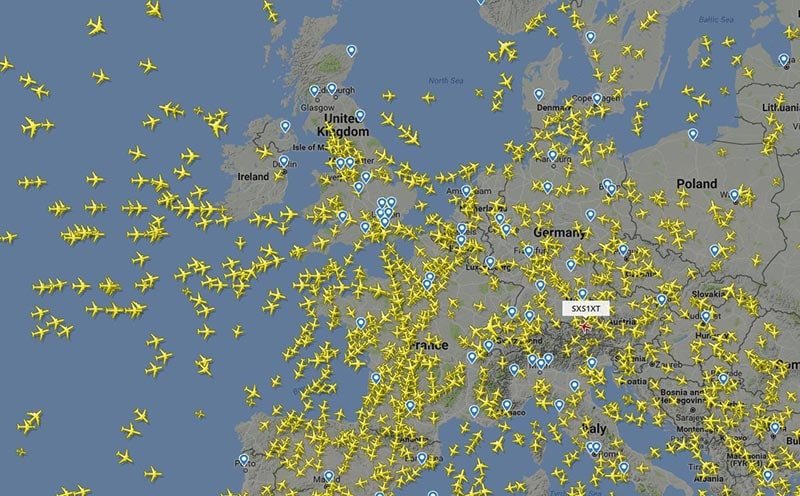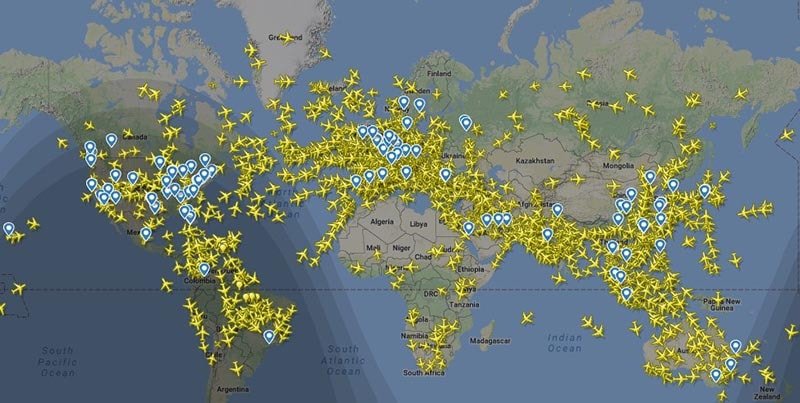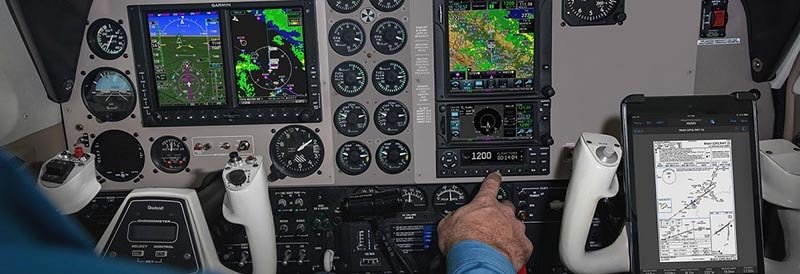Want to know the best flight tracking system in the world? It’s Flightradar24! The fly radar is a service that allows anyone to track route of any commercial flight around the world on their flight radar. On top of knowing an aircraft’s location, you can use this service to track other flight details such as speed, altitude, and many more. Keep on reading to get all the information you need to use Flightradar24.
Flight Radar 24: Live Aircraft Tracking Across the Globe
Facts & Figures
Main Functions
The flight radar 24 app provides excellent coverage with service across the United States, Europe, Canada, etc. Subsequently, it has become the leading service in terms of functionality, speed of providing the necessary information to the users due to high-quality and stable coverage of the resource. Currently, flight radar air traffic makes it easy to see specific popular flights of multiple airlines.
As to the main functionality of the site. The main features is the image of a visual map depicting aircraft in real time that performs regular flights. If you hover your mouse over the plane you need, at the same time, you will be provided with information about its board number, which consists of a set of certain numbers.
When you click on the desired aircraft, to the left of the interface, a dashboard will be opened with full details of the aircraft, namely:
The paid subscription also provides users with no less important information about an aircraft such as:
3D View
The new 3D View Flightrada24 gives you more to see than just facts. There is now an Outside View that includes a realistic 3D model of planes. Outside View allows the camera to move around the aircraft and zoom in and out, so you can follow a flight from whichever angle you’d like. You can move the camera to see what’s directly below an aircraft or see what the sky looks like above.
Moreover, a cockpit view is available, where you can see what the pilots see. In both views, you’re now able to continue viewing full flight information on the left-hand side of the screen. In the lower right corner, you can use the small moving map provided to give reference to the location of the flight you’re following in 3D view.
How To Use Flight Radar?
The software is designed and accessible to all people who have a standard computer, personal laptop, tablet or smartphone, all of these devices must provide the user with access to the Internet. Internet access provides users with the ability to monitor the route of the aircraft you need. Flightradar provides quality coverage in almost all countries of the world.
It is worth knowing that all information provided in the application for all aircraft updates every few seconds, it demonstrates the location of the aircraft on the map.
When you open the website, a map area will appear with many yellow symbols representing a plane in flight. It may look disorderly, but it’s actually air traffic in the world at this moment. If you’re ready, you can start following any flight immediately on the website.
How to resize map area
It is important to familiarise yourself with how to use the map, in order to make sense of it. Preliminary, we must consider the change of scale for the chosen section. When the map is first opened, very broad airspace appears. This represents a large area around your location. In order to make the section smaller you should click on the ‘Magnify’ button, represented by a plus (+) icon. Automatically the number of displayed aircraft is reduced, giving you a clearer view. When using live radar 24 on a mobile device, you can easily zoom in or out using the touch screen.
To move the selected map section up, down, left or right, click and hold on the map with your mouse and move accordingly. If you are using a mobile device, hold the touch screen and drag it in your desired direction. You would have successfully adjusted the map to track the particular flight that you are searching for.
Information window with details
In order to examine aeroplane in detail, you must click on the corresponding symbol on the Flightradar24 interactive map. A new window will open showing all the necessary details. For example, you will see the airline, aircraft type, flight number, and the cities the plane is travelling between. If you scroll down, you will find the live data about the plane’s speed, altitude, and the estimated time of arrival at the destination airport.
For the plane enthusiasts, there is an image of the aircraft that can go into enough detail that you can recognise individual elements such as redwings or painted advertising strips from the ground.
Searching for specific airports and flights
If you want to know what aeroplane just has flown above your head, you can do it! ll you have to do is, enter the name of the airport into the search box, then a map will instantly appear. Perhaps your location does not immediately appear, no stress. Simply drag the map until it shows the correct area. You can also change the setting of the map so that it shows a radius of your desired number of kilometres around your location. With that, you can easily track the majority of civil aircraft above you.
If you’d rather want to know the location of the plane transporting your close ones to another part of the world, then Flight radar 24 can help! In the search box, simply enter the flight number of the flight and its matching flight information will pop up. The new window will have a map displaying the requested plane with all the available information about it.
Mobile App
Take Flightradar24 with you wherever you go with the best flight tracker app for iOS and Android. See detailed information about each flight on a moving map in real-time or just point your device at the sky to see what flights are passing overhead. Download the official app of the best flight radar in the UK and other countries as well for free. Join thousands of people that track flights with Flightradar 24.
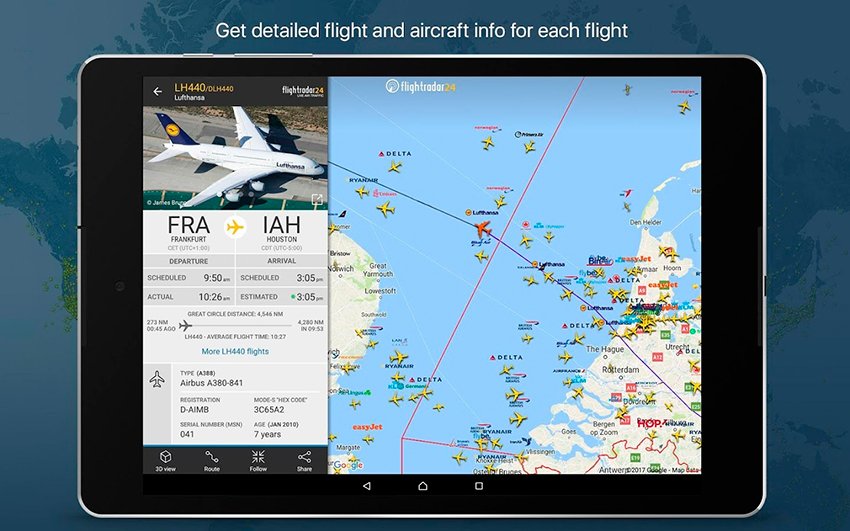
Using the Flightradar24 App
Flightradar24 is a powerful flight tracking app that provides users with real-time information on flights across the globe. With features such as augmented reality (AR) flight identification, detailed flight data, and real-time flight tracking on maps, it’s an indispensable tool for aviation enthusiasts and frequent travellers alike.

Here’s how to make the most of the Flightradar24 app:
Opening the App:
When you open Flightradar24, you’ll be able to see the sky around you in real-time, with planes flying overhead. The app utilises augmented reality (AR) to overlay flight information directly onto your screen when you point the camera at the sky.
Identifying a Flight:
By pointing your camera at the sky, the app identifies the aircraft flying overhead and displays a card with relevant flight details. For example, you might see flight LO3904 from Krakow (KRK) to Warsaw (WAW), operated by an Embraer E195LR. The details include the flight number, departure and arrival airports, airline, and aircraft type.
Detailed Flight Information:
If you tap on the flight information card, you’ll access a more detailed page that includes:
- Aircraft Registration: The specific registration of the aircraft, such as SP-LNE.
- Aircraft Type: The model of the aircraft, in this case, Embraer E195LR.
- Airline Information: Details about the airline operating the flight, like LOT Polish Airlines.
- Flight Details: Information on scheduled and actual departure/arrival times, departure and arrival airports, and the current flight status.
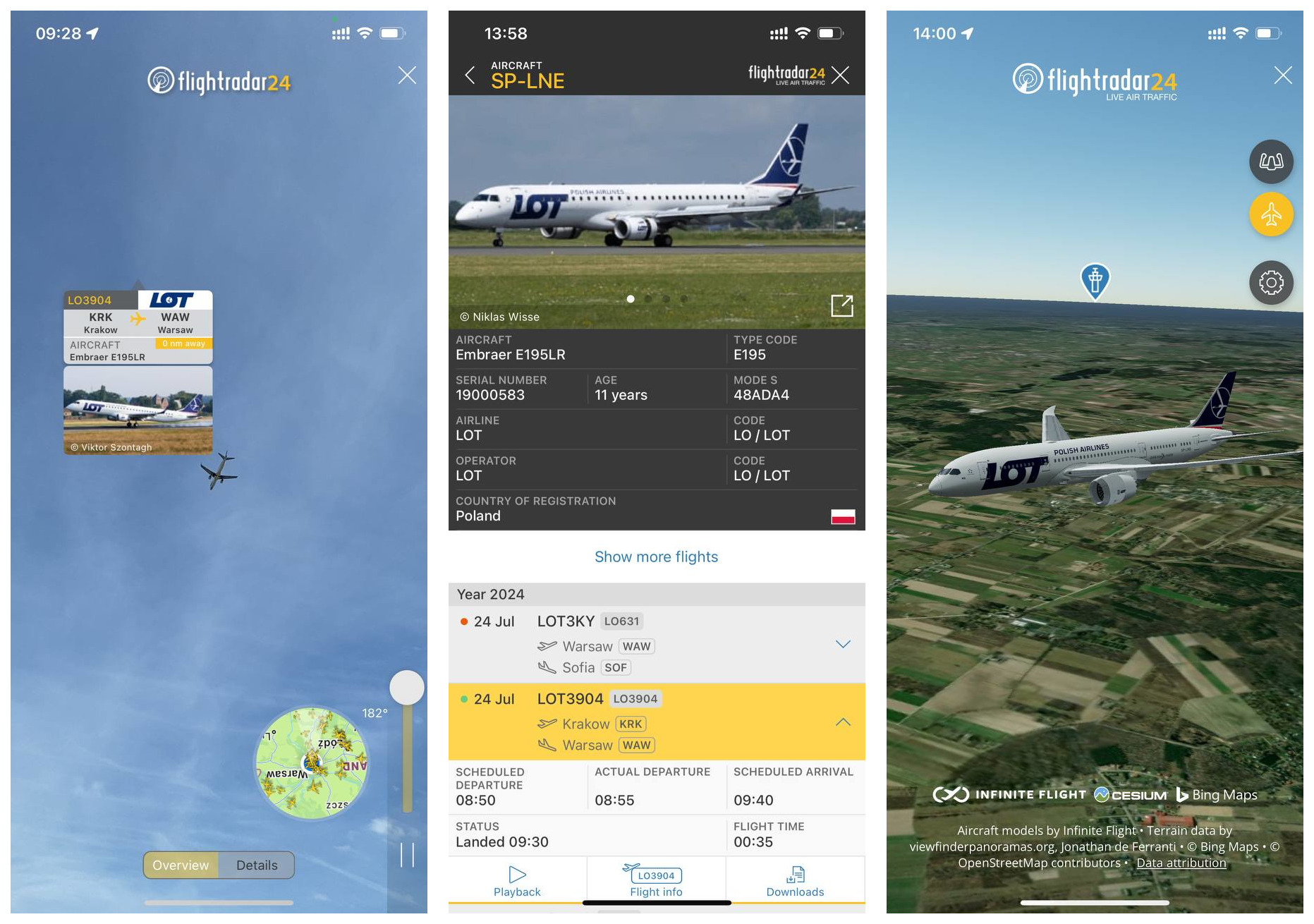
Flight Route and Altitude:
The app shows the flight’s route on a map, tracking the path from the departure airport to the arrival airport. In this case, you can see the route from Krakow (KRK) to Warsaw (WAW). The map also shows the real-time position of the aircraft, allowing you to track its journey.
Flight Data:
Flightradar24 provides detailed flight data, including:
- Altitude: The barometric altitude of the aircraft at different times during the flight.
- Speed: The ground speed of the aircraft.
- Direction and Route: The flight’s direction and its route path.
3D View Feature:
Flightradar24 app also offers a 3D view feature, which allows you to view the flight from a 3D perspective, giving you a more immersive experience. You can watch the aircraft as if you were flying alongside it, which is perfect for aviation enthusiasts who want a realistic view of the flight’s journey.
By following these steps, you can make the most of the Flightradar24 app and stay informed about flights anywhere in the world.
![]()
How It Works
The entire process of transmitting information using ADS-B technology is carried out in the following way:
ADS-B
The primary technology that Flightradar uses to receive flight information is called automatic dependent surveillance-broadcast (ADS-B). Its working principle is the following:
ADS-B is a relatively new technology, still under development, which means that today it’s rarely used by Air Traffic Control (ATC). Recent estimations show that roughly 70% of all commercial passenger aircraft (80% in Europe, 60% in the US) are equipped with an ADS-B transponder. For general aviation, this number is probably below 20%. The percentage of aircraft equipped with ADS-B receivers is steadily increasing, as they will become mandatory for most aircraft around the world by 2020. Once mandatory, ADS-B will replace primary radar as the primary surveillance method used by ATC.
Flight radar24 has a network of more than 20,000 ADS-B receivers around the world that receive flight information from aircraft and send it to the servers.
On cruising altitude (above 30,000 feet) Flight radar 24 covers 100% of Europe and the USA. There is also good ADS-B coverage in Canada, Mexico, the Caribbean, the Middle East, parts of South America, Australia, New Zealand, Asia, and a few countries in Africa. In other parts of the world, the ADS-B coverage varies.
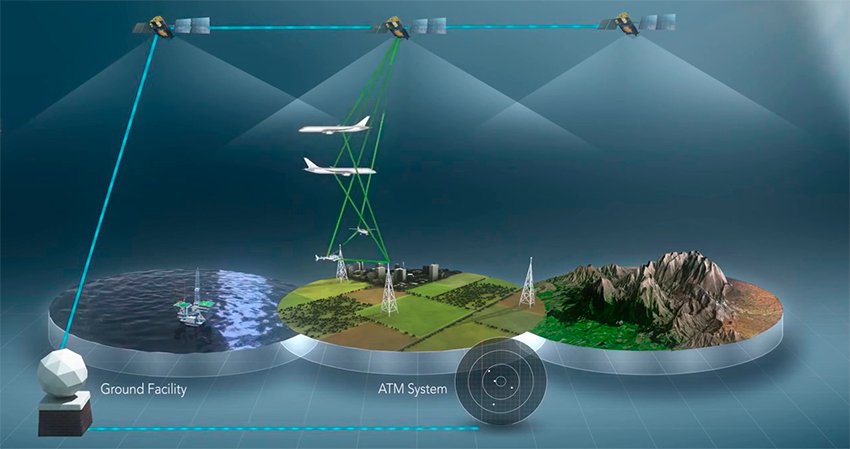
MLAT
In some regions where areas are covered by several FR24-receivers, there os a possibility to monitor positions of non-ADS-B equipped aircraft with the help of Multilateration (MLAT). This is done using a method known as Time Difference of Arrival (TDOA). By measuring the time it takes to receive the signal from aircraft with an older ModeS-transponder. Four receivers or more are needed to make MLAT work. MLAT coverage can only be achieved above roughly 3,000-10,000 feet. As the plane’s altitude increases, the probability that four or more receivers can receive the transponder signal increases as well.
Most parts of Europe and North America are today covered with MLAT above about 3,000-10,000 feet. There is also some MLAT coverage elsewhere with more areas getting MLAT coverage and the coverage is growing day by day.
Satellite
Satellites equipped with ADS-B receivers gather data from aircraft outside terrestrial ADS-B network’s coverage area and send that data to the Flightradar network. Satellite-based ADS-B data available on Flight radar comes from multiple providers. As the number of satellites supplying data and their location are dynamic, satellite coverage varies. Generally, satellite-based ADS-B increases coverage of flights over the ocean where ground-based reception is not possible. The only aircraft equipped with an ADS-B transponder may be tracked via satellite.
North America radar data
In addition to ADS-B and MLAT, there is North America Radar Data for flights there. This information is based on radar data and includes the most scheduled and commercial air traffic in the US and Canadian airspace, as well as parts of the Atlantic and the Pacific Ocean.
Flarm
Flarm is a simpler version of ADS-B with a shorter range, primarily used by smaller aircraft, mostly gliders. The range of a Flarm receiver is between 20 and 100 km. These receivers are often installed on small airports with a lot glider traffic to track the gliders around the airport.
Flying out of coverage Flight Radar 24
When an aircraft is flying out of coverage Flight radar keeps estimating the position of the aircraft for up to 2 hours. In settings, there is an option to set for how long time you want to see estimated aircraft on map.
Which Planes Track?
For today, the resource Flight Radar 24 monitors and provides information by the following types of aircraft:
Video
Not counting your own website, blog, and Flightradar on Twitter, this service also has its own YouTube channel, where every person can view a huge amount of educational and entertaining video clips, and if desired, subscribe on the channel.
Tariff Plans
The basic Flightradar resource provides users free of charge. Paid subscription, as a rule, is more in demand from representatives of aviation business, if necessary, they can get more detailed information with limited access.
Service users can choose any of the resources offered by the site in accordance with their own needs, the need for different data and various information and any other requirements. In spite of your chosen tariff plan, Flight Radar 24 provides you with a pleasure in using fast and affordable information and a simple, intuitive interface, which has made the service so popular.

